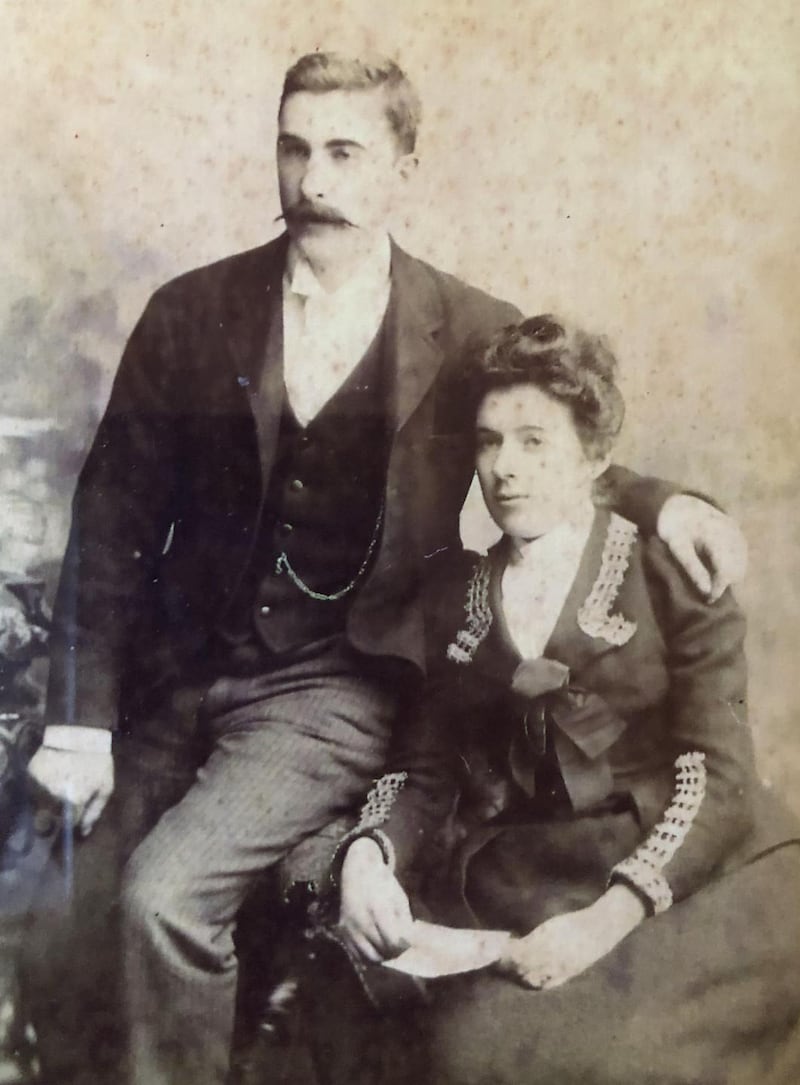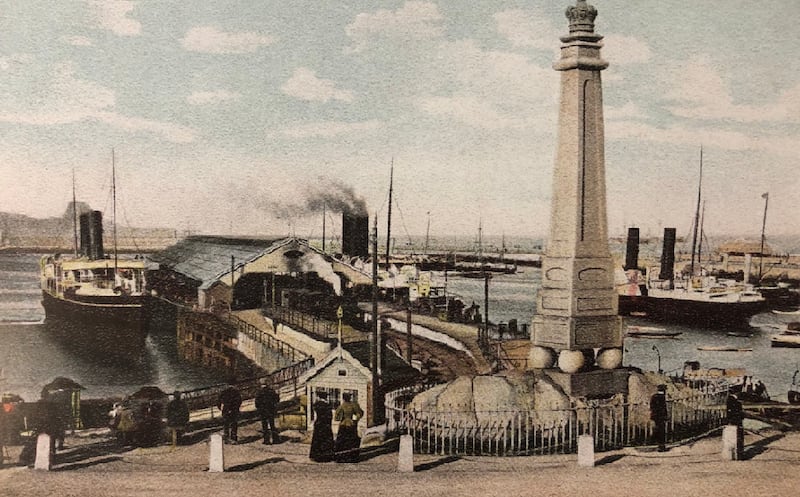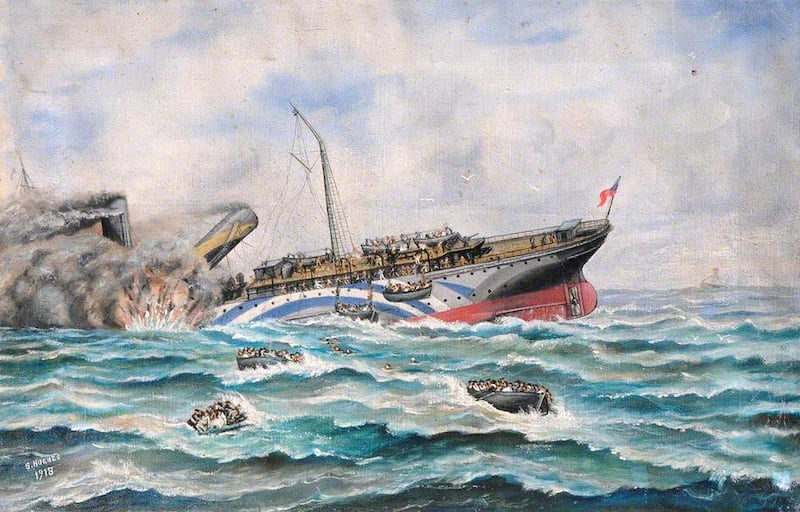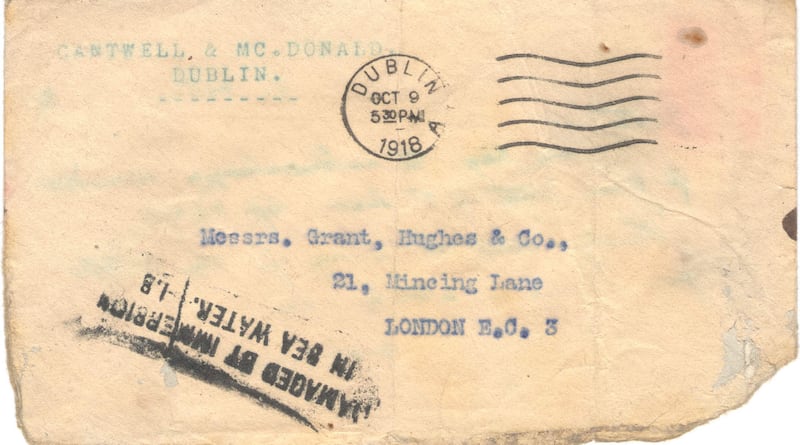We're sitting around the dining room table in Patricia Murphy's home on Clonliffe Road in Drumcondra with three of her four grown-up children, Fionnuala, Trish and Aidan Murphy – the Game of Thrones star who is better known under his stage name Aidan Gillen (which is his mother's name).
The room is full of family pictures, books, and architectural drawings by Patricia’s late husband, Denis Murphy. On the table in front of her she has laid out the documents, memorabilia, records, photographs of the family, which she and Denis researched when he studied genealogy in UCD. He was seriously ill at the time and died in 2005.
Patricia is a feisty woman of 86, full of energy and information, pride and humour. She and Denis specifically wanted to learn about James Joseph Blake, Denis's grandfather, a postal sorter who lived on the same road, at 167 Clonliffe Road. Blake died when the RMS Leinster – better known as the mailboat Leinster – was torpedoed by a German submarine in 1918, a month and a day before the end of the first World War, killing 569 on board.
I am proud he was doing that job in those circumstances, rough seas back and forth. It was 1918 – who knows how many near misses that ship had in the previous four years?
“When they brought up the anchor 15 years ago, the story came more in focus for us,” says Gillen. “My father decided to study genealogy, and that amped up these family stories that were around.”
How it touched the Blakes and Murphys probably reflects how many families feel, 100 years on. Gillen says: “The fact he was on a mailboat that got torpedoed – it was extreme bad luck. He was doing a job which was such a crucial thing – sorting letters on the boat as it went back and forward, which was the forefront of communications technology at the time.
“I am proud he was doing that job in those circumstances, rough seas back and forth: it couldn’t have been all that pleasant. It was 1918 – who knows how many near misses that ship had in the previous four years?”
They never found James Blake’s body. His wife Catherine (Fay) died two years later; the family thought it was of a broken heart, says Patricia. Her father, brother, and now husband, had died at sea.
Aidan adds that her death cert said she had died from exhaustion. They had eight children (their surviving children were aged 12 to 23 when James died at 51 on the Leinster). Michael Collins was reputed to have stayed in their house when he was on the run. Patricia has photographs of each of the four girls, who apparently made quite the splash as the Blake Quartet of singers in the 1920s. Two sons took part in the 1916 Rising.
James’s youngest son Daniel was a fine soccer player; the garrison game was reputedly handy as it allowed his older brother Joe, who was in the IRA, to covertly spy on British soldier activity when at matches. Joe later went on the run, ending up in California.
Years later, Gillen says, he tracked down his grand-uncle Joe’s grave in east LA. “He seemed to have two names: Joseph Blake or Fay, or Tom Fay.”
James Blake’s story, and how the events touched his family, is emblematic of all the stories of the 569 people who died, and the 201 who survived; those tentacles now spread out across the globe.

1918 Ireland
Ireland in October 1918 was a complex world. The war would end the following month, and the December election would change the country for good.
The City of Dublin Steam Packet Company's mailboat RMS Leinster crossed daily between Dún Laoghaire, then Kingstown, and Holyhead in Wales, carrying mail that was sorted by post office staff aboard. The ship also carried civilian passengers – the only way to get off the island was by sea – and space for 500 soldiers on the boat was requisitioned by the British army.
So it was a mailboat and civilian ferry, but it had camouflage markings (“The look of it was startling,” says Gillen, “modernistic, almost German expressionist”) and carried defensive weaponry. It was, from this vantage point 100 years later, a dangerous combination, of civilian, postal and military vessel. It was clearly seen by Germany as a military target.
On the morning of October 10th, 1918, the mailboat left Dún Laoghaire with some 771 people (there is dispute about numbers; travel across the Irish Sea was casual and records are not exact). There were 77 crew (from around Dún Laoghaire and from Wales) under the command of Capt William Birch. The ship also carried more than 100 civilians, mainly Irish and British, of all social classes, 22 postal sorters from Dublin in the mail room and almost 500 soldiers, many of whom had been on on wartime leave and were returning to the front.

The torpedoes
Between 9.30and 9.40am, the Leinster passed the Kish Light. Shortly afterwards, and still within sight of Dún Laoghaire, in a heavy swell, a torpedo fired by the German submarine UB-123 struck the ship forward on the port side, near the mail room. The hull was breached and 21 of the postal sorters were killed. The 22nd sorter was on deck, smoking.
Capt Birch ordered a return to port, but another torpedo struck the Leinster, leading to a huge explosion, which caused most of the deaths aboard. One can only imagine the turmoil and chaos. Survivors struggled to get on to lifeboats or hold floating pieces of wood. It would be hours before rescue boats arrived.
Afterwards, people described seeing the recovered bodies piled on the pier, and families searching for loved ones. Many bodies were never found. It was, and remains, Ireland's greatest maritime disaster; more Irish people died on the Leinster than on the Titanic or Lusitania.
The tentacles of memory and witness spread out among those touched by the sinking 100 years ago. As Gillen notes: “James Blake was from republican family, but there were affluent people, nurses, doctors, military personnel, Irish and English. And all the guys on the German sub were killed on the way back . . . that’s what happens in war. It doesn’t really differentiate.”
They all have a story to tell and those stories have been pieced together over the past 15 years and more.

The passengers
At the National Maritime Museum in Dún Laoghaire, Brian and Lucille Ellis and Philip Lecane have spent years on an ongoing project collecting details and creating an impressive interactive touch screen with information on every passenger on the Leinster's final voyage.
And the Mail Boat Leinster Centenary Committee, especially Breasal Ó Caollaí, have put together a commemorative book, The Last Voyage of the Leinster, which includes many descendants' memories.
William Maher was one of the heroes of the Leinster. A stoker on board, he held on to 13-year-old Dorothy Toppin as they clung to a life raft for hours before being rescued. As he helped her mother on to the launch, the child slipped from the side of the raft into the water and he dived to rescue her. They survived and Maher was awarded a silver medal and certificate for bravery from the Royal Humane Society. A monument will be erected on his unmarked grave in Deansgrange this week.
Postal sorter Adam Smith was not due to work on the 10th but was asked to stand in for an ill colleague. The family’s story is that his daughter, Mary Claire (Daisy), was the last to see him alive as she ran after him with the sandwiches he had forgotten. He left a wife and nine children, aged two to 17.
Fanny Saunders was on the Leinster to visit her seriously ill daughter in Holyhead. Her lifeboatman husband had previously died at sea. When Fanny's young sister, a child, went down to Dún Laoghaire pier as the casualties were brought in, she saw the red shoes Fanny had bought for her trip sticking out from a blanket covering a body.
James Carraher from Co Wexford was in the navy. A bosun, he gathered many victims, including an infant, on to a raft, staying alongside as they waited for hours to be rescued
Arthur Cohen led a very dramatic life. His parents emigrated from Lithuania to Belfast in 1890 and as an adult he moved first to South Africa then Canada to seek his fortune. He was bankrupted in Ireland and England in 1915. In 1918 he joined the British army and was aboard on October 10th. He was rescued after several hours clinging to a piece of debris. An atheist, he prayed for hours that if he survived he would forever say Jewish morning prayers – and he kept his promise.
Nurses Margaret and May O’Grady, sisters from Newmarket-on-Fergus, Co Clare, were returning to England after visiting their parents. Their brother Joe was in the US army and had died six months earlier. May’s body was never recovered, and Margaret is buried in Quinn Abby, Co Clare. Their nursing registration certificates were found floating on the water.
James (Jem) Carraher from Co Wexford was in the navy. A bosun, he gathered many victims, including an infant, on to a raft, staying alongside as they waited for hours to be rescued. He was traumatised by the horrors but spent the rest of his life as a mariner and years later survived another sinking.
Tom Connolly, a 16-year-old cabinboy and his father Philip (“the Greaser”) from Dalkey both survived. Tom’s daughters Ollie Gray and Dinah Jordan tell how their father and grandfather were on different areas of the boat when the torpedoes struck, but somehow ended up at the rails together. They jumped together, holding hands.
Recall is a strange thing; another family story has the father jumping first while the son hesitated.
Philip’s wife was on the pier grief stricken, “getting someone to turn the blankets over from bodies to show her”, says Gray, when she saw her husband and son walking towards her. With the shock, “she took to the bed”.
Teenager Tom Connolly had a different reaction. As a survivor he got a crown (2/6) and a blanket. And after walking home in the blanket he went into town and used some of the money to go to a variety show, says Gray.
It is remarkable how far away the effects of the disaster are felt. Anne Burrows and her brother Andrew Sinkovich are this week in Dublin, part of a family group of 14 from New Zealand for the centenary, to remember their grandfather Joseph George Robinson, a postal sorter who died aged 43. His widow emigrated to New Zealand with her family four years after the sinking.

Aftermath
The aftermath to the massive loss of life was fraught and controversial. Many facts were never established and calls for a public enquiry were refused by the British, who presumably didn’t want to exacerbate their wartime embarrassment. Censorship continued after the war.
The Evening Herald was shut down for four days merely for reporting the sinking (before the deaths were even known about) without censor approval. The press censor prevented any information being published that there were soldiers on board.
Many questioned were asked afterwards why the boat was not properly protected from attack by observation balloons overhead? Rumours circulated, of bad behaviour by a few soldiers aboard, alleged to have prioritised their own safety over women and children, or of personal guns aboard and bullet wounds on corpses, to more gossipy rumours, about a senior crew member leaving two families, one in Dublin and one in Wales, or more outlandish ones, of spies at the Royal Marine Hotel.
An interesting postscript is in the statements issued by Sinn Féin and the IRA after the sinking. In An tÓglach of October 29th, 1918, an Irish Volunteers statement denounced the English government for insisting on using passenger ships to carry soldiers, turning civilians away to make room for them. It wrote: "The spectacle of English soldiers sheltering behind women and children is a revolting picture."
In the many decades that followed, memories seem to have faded, and for such a tragic and controversial event, little was remembered about the Leinster
An tÓglach claimed two American naval officers on board said the English soldiers "behaved with incredible cowardice and brutality when the ship was struck by the torpedo, trampling down women and children in the rush for the boats".
It reported: “One of the rescued lady passengers was badly bruised as a result of blows struck at her by the soldier; and the body of one of the drowned women had a bullet wound in it”. The Irish Volunteers’ statement says the American officers “paid a tribute to the fine behaviour of the crew – all without exception Irishmen or Welshmen”.
The Sinn Féin statement of 1918, quoted in Roy Stokes's book Death in the Irish Sea: The Sinking of the RMS Leinster voices the same accusations.
There was a febrile atmosphere of 1918, with propaganda and counterpropaganda swirling. Sinn Féin had numerous victories in the crucial 1918 election in Ireland just a few months later.
Move to remember
In the many decades that followed, memories seem to have faded, and for such a tragic and controversial event, little was remembered about the Leinster.
National Maritime Museum president Richard Mc Cormick was a trawlerman in his youth. "I fished around the RMS Leinster wreck in the 1960s with local Dún Laoghaire skippers Brian and Leo Crummey and no one seemed to know much about her, which I found very strange considering the huge loss of life."
The move to remember has been gradual but insistent.
Late seaman Des Branigan (serendipitously, born in 1918), one of Ireland's first scubadivers, bought the Leinster wreck to prevent it being plundered. He donated an anchor to Dún Laoghaire; it was recovered by divers, restored, and has been displayed on the seafront since 1996.
William Byrne, whose great-grandfather John Donohoe was chief stoker on the Leinster, and survived, after giving his lifejacket to cabin boy Tom Connolly, campaigned for commemoration since he was a schoolboy. In 1998 Roy Stokes published the first book about the ill-fated vessel, Death in the Irish Sea: The Sinking of the RMS Leinster, and Philip Lecane's research led to his, Torpedoed!: The R.M.S. Leinster Disaster in 2005.
As awareness of the sinking has grown, there has been a striking level of voluntary effort locally to remember the event, with the many strands of commemoration coming together this week.
RMS LEINSTER COMMEMORATIONS
The National Maritime Museum (mariner.ie) in Dún Laoghaire has memorabilia and is hosting art exhibitions, open days, a concert, ecumenical service, hedge school and seminar, as well as the impressive ongoing touch screen at the museum, with information about every person on board the last voyage; rmsleinster.com reaches out to the greater RMS Leinster family of survivors.
The Mail Boat Leinster Centenary Committee (leinster2018.com) of 27 people in Dún Laoghaire, focusing on family and friends of the Leinster, has an information hub and 1918 memorabilia in the town's shopping centre with event and concert tickets.
On Wednesday, October 10th, Patrick Street in the town will become a 1918 street. A boat will sail early morning to lay a wreath at the site of the sinking and local church bells will ring to mark the first torpedo strike.
At 11am the State centenary event is at the Lexicon library. dlrcoco.ie/events
A short film, RMS Leinster Commemoration, by Tile Films, plays at IMC cinemas.
An Post is marking the centenary with a commemorative international stamp with a painting by the Irish artist Brian Palm, a performance, A Fatal Voyage, at Dún Laoghaire's Pavilion Theatre and a book, Sorting Letters on the Sea. An Post staff across Ireland will observe a minute's silence at 9.50am on October 10th.
Philip Lecane's Women and Children of the Leinster is published for the centenary. RMS Leinster: The Forgotten Tragedy by Carmel Uí Cheallaigh, with an English and Irish edition aimed at eight- to 11-year-olds, is published by Elm Books.
Holyhead in Wales lost 27 on the Leinster – 25 crew and two soldiers; more than 70 children were left fatherless. The town hosts a commemorative service on October 10th.









